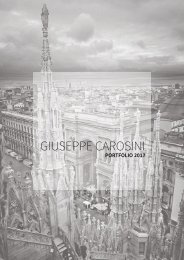Create successful ePaper yourself
Turn your PDF publications into a flip-book with our unique Google optimized e-Paper software.
ecommends one shower per 50 persons and one communal<br />
latrine per 20 persons. Hygene facilities should<br />
be separated by gender.<br />
- Water collection places<br />
- Clinics, hospitals and immunization centres: UNHCR<br />
recommends one health centre per 20,000 persons and<br />
one referral hospital per 200,000 persons.<br />
- Food distribution and therapeutic feeding centres: UN-<br />
HCR recommends one food distribution centre per 5,000<br />
persons and one feeding centre per 20,000 persons.<br />
- Schools and training centers: UNHCR recommends one<br />
school per 5,000 persons.<br />
Some facilities, such as schools or markets that make a<br />
camp look or feel more permanent, could be prohibited<br />
by host country government.<br />
In reality, these already overcrowded facilities become<br />
more overcrowded: new people arrive into the camp,<br />
but the infrastructure remains the same.<br />
In order to enter the camp, the refugees firstly need to<br />
be registered at the camp’s reception center. Sometimes<br />
queues are so long that waiting times up to two months<br />
are possible. Suffering from mostly malnutrition and<br />
dehydration many die while waiting, since the people<br />
outside the reception center are not entitled to the official<br />
support and medical care. After their refugee status<br />
is granted, they are transported to the camp.<br />
remedies against abuses and can’t appeal against their<br />
own ‘courts’.<br />
The host country is usually responsible for the security<br />
of a refugee camp. It provides military or police, while<br />
UNHCR is supposed to provide legal protection. However,<br />
local police or the legal system of the camp-hosting<br />
countries are not usually not willing to get involved<br />
in issues occurring inside the camps. In many camps,<br />
refugees create their own patrolling systems as police<br />
protection is insufficient. Most camps are enclosed with<br />
barbed wire fence. This is not only for the protection of<br />
the refugees, but also to prevent refugees moving freely<br />
or interacting with the local people.<br />
Although under International law refugees are granted<br />
freedom of movement, it is rarely the case in practice.<br />
Possessing Movement Passes from the UNHCR or the<br />
host country government does not guarantee an option<br />
of leaving the camp; in Nauru camp, for example, refugees<br />
are given travel documents, but they cannot leave<br />
since they are isolated on the island.<br />
Due to crowding and lack of infrastructure, camps can<br />
become unhygienic, leading to a high incidence of infectious<br />
diseases, even epidemics. Common illnesses are<br />
malaria, cholera, jaundice, hepatitis, measles, meningitis<br />
and malnutrition.<br />
91 LIFE IN LIMBO<br />
According to UNHCR vocabulary, a refugee camp<br />
consists of: settlements, sectors, blocks, communities<br />
and families. 16 families make up a community, 16<br />
communities make up a block, four blocks make up a<br />
sector and four sectors are called a settlement. Settlements<br />
and markets in bigger camps are often arranged<br />
according to nationalities, ethnicities, tribes and clans<br />
of their inhabitants A large camp may consist of several<br />
settlements. Each block elects a community leader to<br />
represent the block.<br />
Refugee camps are monuments to human suffering,<br />
and the sheer size of these settlements testifies to the<br />
severity of forced displacement around the world. Yet,<br />
the settlements are also spaces of hope and optimism:<br />
for many inhabitants, these camps represent a stepping<br />
stone on the path to safety and prosperity.<br />
The refugee community elects a leader who is responsible<br />
of mediating and negotiating to resolve problems,<br />
and liaise with refugees, UNHCR and other organizations.<br />
Many refugees mistrust them and there are allegations<br />
of aid agencies bribing them.<br />
Refugees are allowed to establish their own<br />
“court’’where the jurisdiction is provided by elders<br />
and elected leaders of the communities, and financial<br />
support from charities. Refugees are left without legal




